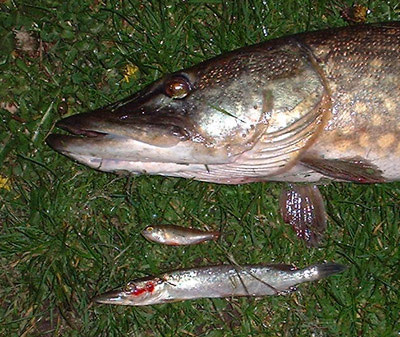|
Diet of the Pike

Newly-hatched pike fry live on their yolk sacs for several weeks but they need to capture invertebrate food when they are 10-12mm long. By the time they have grown to 5-6cm long, pike tend to switch to a diet of fish. This explains why pike usually spawn sometime before their prey: the young pike have grown large enough to eat other species of fish just as they hatch!
The dietary requirements of pike are also and, in general terms, a diet comprising between 13oz and 1.5lb of prey fish per pound of pike per annum is needed to merely keep the pike alive (their 'maintenance ration'). Where pike are undergoing normal growth 2.5-3.5lb of prey fish per pound of pike per annum is a common ration which ensures such normal growth.
Conversion from prey flesh to pike flesh can also be predicted, and the ratio between weight gain and total food consumed during normal growth is often between 1:5 and 1:10.
Prey choice seems to be governed entirely by its availability to pike. However, there is some evidence that pike may select soft-rayed species in preference to fish bearing spines. Although there are reports that spined fish (usually perch or related species) are the dominant prey of pike. For example on one water analyses of the stomach contents of large pike revealed substantial numbers of perch and relatively few trout. That pike tend to be opportunist, rather than selective, predators is supported by the fact that the stomach contents listed by several workers comprised nearly the entire range of fish species present at the studied sites.
For example where perch and char are present the pike tend to feed on perch for most of the year, but char figure highly in the pike's diet during the autumn. The explanation is that the char move from their usual deep-water habitat and shoal in shallow, marginal areas in readiness for spawning at this time of year!
The scientific literature does not support the notion that pike will always 'prefer' a particular prey species irrespective of its abundance. This undermines the theory that pike will actually select salmon or trout in game fisheries; pike tend to eat whatever they can catch most easily.
|